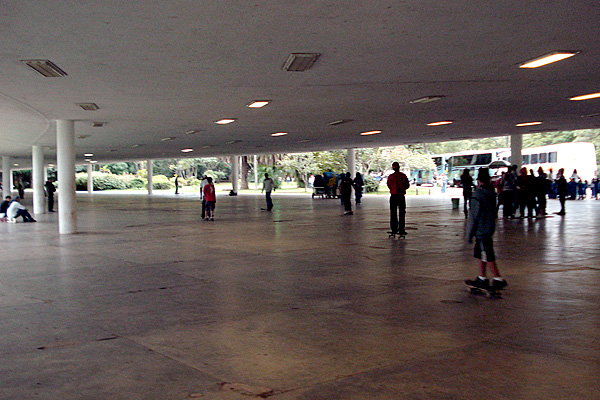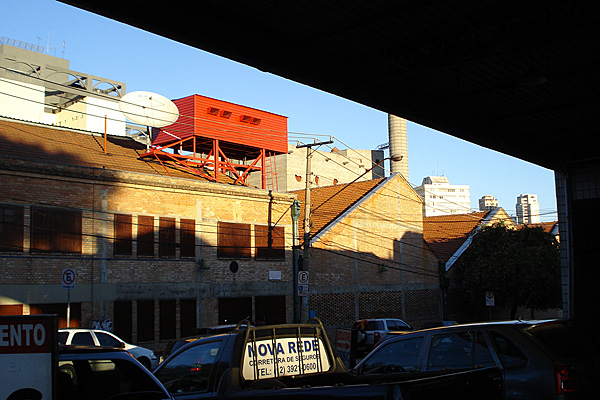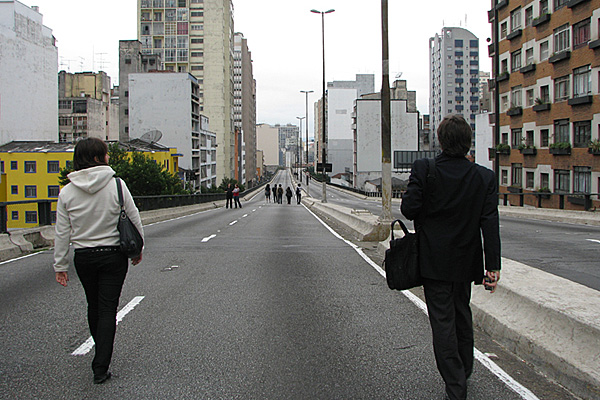São Paulo: In the Flow of Space
‘Let us meet at the marquee’ , I hear Paulistas say without choosing a meeting point or specific location. ‘Let us meet in the afternoon…’ place and time are not definite, rather a notion of a more elastic space, in the flow of time and movement we will meet, walk under Niemeyer’s marquee in Ibirapuera.
Without a vantage point, preferred direction or entrance, without a start or an end, the marquee creates a continuous sense of flow, a space that doesn’t come to a stop, but turns and twists and continues on and on, curved and meandering between landscape and buildings, covered and opens area. It is a space of flow, of movement.
One large form, or motion, yet without a prescribed shape, nor confined or bounded. The jumping rhythm of the columns provides the beat — determined by speed of travel, on foot, bike or skate board… Scale is perceived first by columns, height of roof, then through the landscape elements along, within the park. The marquee, intended to offer a roofed connection between several buildings located in the park, becomes the main piece, buildings simply appear along it, supporting it, stations of other activities.
On the drawing board any architectural review would have criticized this design: it is too big, too empty, what would you do in such a place? The reality offers that which cannot be drawn: movement of people, children, air, voices, music, play, it provides a sense or order, but not imposed, without enclosing anything off — without demarcating boundaries –an architecture without walls, a space without limits.

São Paulo: Endless City
This notion of the endless…, on the regional scale, when urban growth continues to expand and further expand — we are lost in this jungle, we lose a sense of scale, maybe a problem of disorientation? São Paulo’s urban structure is unclear, its expansion is unpredictable. Unlike gridiron cities, such as Los Angeles, or Mexico city, São Paulo’s topography adds another layer of complexity.
The city can no longer be contained or confined — we do not have the mechanism to do so. Aside the planned, regulated developments, there exists informal growth — which although might draw protest from an urban point of view, is in fact an inevitable outcome of the economic logic that structures many societies. The ‘retreat’ from the city is not necessarily to be found outside it, but in its inner spaces which can re-create a sense of collectiveness aside a place for the individual.
Conventional maps are often useless — even if one attempted to draw a map of the city, by the time this task could be completed, the city would have already changed so much a new map would need to be drawn. Taxi drivers pick up a book of plans to find an address – a series of street maps, arbitrarily cut squares determined by the size of the page, fragments of neighborhoods, patches of isolated urban fabrics. Moving between these squares is sometimes more difficult than moving between countries.
In the workshop we divided time between a room at the Casa da Cidade and the city.
At the MASP — we asked: why aren’t there any columns? I doubt Lina Bo Bardi’s levitating Museum could have been built anywhere else. It is so straight forward — does the obvious yet in a most surprising way.
The minhocão was closed off for pedestrian use only on May 1 holiday. A space which cannot be occupied by pedestrians and cars at the same time, therefore alternates; Sundays and holidays for people. A new landscape is revealed –this can become a true urban promenade, it might enter into a park at some point, and out again, connected directly to upper level floors of the buildings flanking its sides. A new datum, another layer of movement.
The Copan, with all its size and presence, still offers what so many large scale residential projects failed — a variety of apartment shapes and sizes with one architectural expression (there is freedom and flexibility in the inner subdivisions much more than Le Corbusier’s unité). Far more than a collection of apartments, this expression relates to the urban scale — as this wave is both an object and a background to the city, a setting for other buildings.
We realize that much work needs to be done on the urban level. All these examples and others reflect the potential to work with urban space. It is not necessarily a question of what we put into the city, but rather how space can be created, or re-covered. In the spread-out dense urbanism of São Paulo we asked — what can be taken out of the city.
Michelangelo said of Firenze that it was like a huge piece of stone of which streets and squares were carved out — as a sculpture standing in front of a piece of stone — he sees what needs to be taken away to reveal a form. Is the form already inside the stone?
The city is our material to work with, although not a single piece like Michelangelo’s Firenze, it still offers all we need — the forms and spaces are already within — remained to be revealed.

